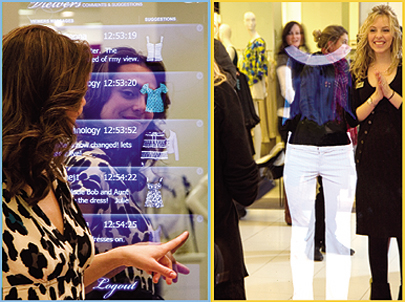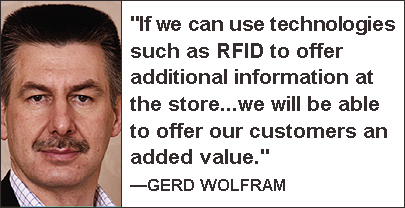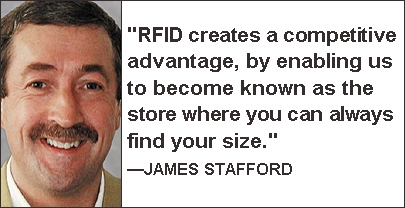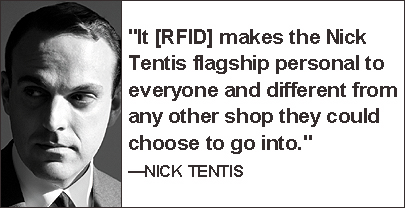By Jennifer Zaino
Robert Savage is convinced he’s seen the future of retailing, and he credits his 8-year-old daughter for the insight. Observing her use of the Internet and text messaging to share experiences with friends, the president of Nanette Lepore fashions had an epiphany: Social networking is changing the expectations of young people in myriad ways. Sooner or later, it’s going to affect the way they want to shop.
If Savage has his way, it will be sooner. He hopes to partner with a high-end department store where Nanette Lepore clothing is sold to offer consumers an RFID-enabled “social retailing” shopping experience. It would allow a woman to show remote friends and family the items she’s considering and get their immediate feedback. The concept was tested in March for three days at Bloomingdale’s in Manhattan. “We want to be cutting-edge not only in fashion, but in retail as well,” he says. “It’s good for the brand.”

Savage has been collaborating with IconNicholson, a full-service digital agency that worked on an RFID installation at Prada’s Manhattan store, which included reader-equipped hot spots where customers could take a tagged product to find out whether it was available in different sizes or colors. (A fire about a year ago destroyed much of the RFID infrastructure.) In a real-world deployment, the Nanette Lepore RFID project could work like this: A shopper would go to an area outside the dressing room where a three-paneled interactive mirror would be located. The mirror would have a built-in RFID interrogator and a high-definition video camera, and the Nanette Lepore fashions would carry ultrahigh-frequency tags. When the shopper stood in front of the mirror with the tagged clothing, the mirror could display information such as other sizes or colors of the items in stock, or recommend accessories to pair with the outfit.
The RFID system would also allow the shopper to use her cell phone to upload the e-mail or IM addresses of chosen friends and family members, who would receive a message containing a link to the Web site where her fashion session was being broadcast. They could go to the site to see what clothing she was considering and use applets on the site to, for instance, vote on whether the outfit was “hot or not,” or type in comments recommending another accessory. The shopper would then view the comments on one of the mirror’s panels.
Social retailing could have particular appeal to Net-savvy, text-message-obsessed teenagers, but Savage thinks it applies even more generally to Nanette Lepore’s clientele, regardless of their age. “It’s the way women shop,” he says. “They like to have input.”
RFID technology could help manufacturers and retailers redefine the in-store shopping experience for consumers. As online shoppers increasingly become accustomed to having instant access to information—from whether a particular item is in stock to the social principles of the company—they’re going to expect the same service from brick-and-mortar retailers.
“How do I support the fact that I can get tons of research online but no information in store?” asks Rachael McBrearty, former VP of creative strategy at IconNicholson. “Why aren’t we starting to think about what customers really need when they’re shopping?”
A few retailers are starting to think about this, either piloting or deploying in-store RFID applications designed to improve customer service. In a pilot at Japanese department store Mitsukoshi, which was completed in February, shoppers were able to get information on RFID-tagged Shiseido skin-care products via a touch-screen terminal, and try on virtual makeup at a kiosk equipped with a camera, display and RFID interrogator. Mitsukoshi’s test of RFID at the cosmetics counter required its supplier to handle the tagging in the supply chain. The system, designed by Fujitsu, was tested at the Ginza shopping district store in Tokyo and the Skakae branch in downtown Nagoya. The pilot was one of the retailer’s first steps toward becoming what the company calls “the department store of the future.”
When Mitsukoshi asked customers whether they would be deterred from buying RFID-tagged cosmetics, 94 percent of those surveyed said no—as long as it would enable them to access services offered during the pilot, including RFID@home. In a real-world deployment of the RFID@home service, customers could buy or rent a tag reader and use it to get detailed product information on their purchases right from their home computers. Still, Akihiko Ikeura, Mitsukoshi’s merchandising project leader, says the retailer wants to fully address privacy issues, as well as tagging costs, before such a pilot could go live.
In another pilot at an unnamed apparel retail store in Mumbai, India, customers who agree to carry an RFID-enabled card or key fob could get a good deal on select items. The pilot system from RFID startup Consumer Vision uses passive high-frequency tags to identify shoppers when they enter the store and alert them via their cell phones, video screens and other devices to sales and promotions of special interest.
This summer, design company Nick Tentis, which specializes in high-end men’s clothing and accessories, is opening the Nick Tentis Living Retail Theatre in London. Nick Tentis is developing item-level RFID applications that will be used to track goods through the supply chain, manage inventory and provide in-store services to customers. The store will feature the interactive RFID-enabled MagicMirror, developed by Paxar; it can read RFID-tagged items and provide details about the product or suggest in-stock accessory items to accompany it.
The Big Space, a merchandising solutions provider, is customizing the MagicMirror for the Nick Tentis Living Retail Theatre. At the front of the store, a MagicMirror will act as a style guide, enabling buyers to get rich content about a piece of clothing. In the fitting room, the mirror will be used to cross-sell accessories. “But most importantly,” says managing director Nick Tentis, “the tag will trigger the lighting and music in the fitting room to change based on the qualities of the piece the customer is trying on.” For instance, if it is an evening suit, the lighting will dim and the music will adapt to represent the nighttime dining environment where the buyer likely will be wearing the piece.
The company also is offering an RFID loyalty card that customers can use every time they enter the store to get personalized information via the MagicMirror on new collections tailored to their preferences, fitting schedules or other details. This will be an opt-in program for loyal customers who want that level of personalized service.
“It’s about making RFID work for customers,” says Frank Dekker, CEO of The Big Space. At the same time, RFID will work for businesses. For instance, retailers often lose sales because shoppers don’t like to leave the dressing rooms to search for different sizes. Customers can use the MagicMirror to request that a sales associate bring an item in another size or color to the fitting room.
From Item-level Tagging to Innovation
All of these consumer RFID applications depend on item-level tagging—which is itself in its infancy. Some early adopters have been testing item-level tagging and seeing benefits, including increased sales and a reduction in labor for restocking. But most retailers are not investing their technology dollars in RFID, according to findings by the National Retail Federation (NRF). “In the brick-and-mortar environment, there’s still a lot of money spent on traditional point-of-sale hardware, and upgrading networks and telecommunications, to enable the transfer of information back and forth,” says Dawn O’Brien, NRF’s senior director of retail systems.
Germany’s Metro Group, which has the highest-profile Electronic Product Code RFID deployment in Europe, estimates that it will be 10 to 15 years before RFID will be used on the item level on a broad scale. The company, the fourth largest retailer in the world and the largest in Germany, has been focusing on using RFID in its supply chain, to optimize processes in logistics and warehouse management. But recognizing the future of item-level tracking, it is tagging select items in its Future Store in Rheinberg. The tagged products are stored on so-called Intelligent Shelves, which can recognize when certain items are running low so the shelf can be replenished. In March, the company also announced plans to begin testing the use of UHF RFID technology for tracking high-value garments and accessories at the item level.
Using RFID at the item level will make several other trailblazing innovations possible that will benefit customers, says Gerd Wolfram, managing director of MGI Metro Group Information Technology and the person responsible for the deployment of RFID within Metro. “If we can use technologies such as RFID to offer additional information at the store, such as the origin and ingredients of a product, quick navigation through the store, smart catwalks, smart dressing rooms and smart shelves, we will be able to offer our customers an added value, which can be a very good answer to the challenge of the Internet,” says Wolfram. “Digitalization is not reduced to the WWW!”
Even when game-changing customer experiences isn’t the end goal, retailers that have deployed item-level tagging to address some fundamental business problems—such as out-of-stocks and loss of inventory due to shoplifting, employee theft or supplier fraud—say their clientele notices a difference. “The evidence for better availability comes from comments our customers made to members of our store staff, and their own observations of the merchandise in store,” says James Stafford, head of RFID at Marks & Spencer. The U.K retailer is expanding its RFID tagging of complex-size items, such as bras and men’s suits, to 120 stores this year. “This is more than just anecdotal,” he says. “Listening to customer comments is a fundamental part of our business.”
While its RFID implementation is still in its early stages, Stafford expects that better availability ultimately will enable the retailer to get a truer picture of customer demand for each size, thereby allowing it to match its buying profile more accurately to customer needs in the future. “RFID creates a competitive advantage, by enabling us to become known as the store where you can always find your size,” says Stafford. “Companies who do not adopt this technology risk being left behind in meeting customer expectations.”
Some RFID vendors are developing solutions to make it more cost effective for companies to support new consumer services that are based on having tagged items in the store. They believe that once the RFID infrastructure is in place, using it to power consumer applications will be a natural next step. Vue Technology, which has worked on several item-level pilots, says its TrueVue RFID platform, which includes integrated RF networking hardware and Electronic Product Code management software, addresses one of retailers’ core concerns: total cost of ownership for item-level deployments. Typically, item-level deployments are dependent on installing a large number of antennas and readers, but Vue says with its networking devices, any standard RFID interrogator can be networked across thousands of antennas, making it possible to support many more zones or read points.
Neco Can, VP and partner of global business solution provider Attevo, believes that cost shouldn’t stop retailers from moving forward now on item-level deployments. Depending on what a retailer wants to do, it can cost as little as $15,000 to $20,000 for an infrastructure for reading items as they come into the store, and move from back room to front room to dressing room—plus the costs of tags, which can range from 10 cents to $5, depending on the item. In addition, he says that retailers don’t need to modify their legacy systems. If they convert RFID numbers in their databases to SKUs, all their legacy systems will work.
Ahead of the Curve
It’s clear that many retailers and suppliers are cautious when it comes to item-level tagging. “Retailers don’t have the staffing, expertise, knowledge and logistics to go in and do [item-level] testing themselves,” says Bob Brown, CEO of the Spar Group, a merchandising services company that is in the test phase of a project with Circuit City to tag DVDs for one of its stores. And Metro’s Wolfram says standards need to be finalized for the global flow of goods in order to expand RFID adoption into the sales room.
But it’s equally clear that the early adopters who are moving forward with item-level pilots have good reason and high expectations for being ahead of the curve. Mitsukoshi, for instance, is convinced that RFID can enable a stress-free store experience, which is good for business. “For everyone working for Mitsukoshi,” says Ikeura, “it is always our object to improve the skills of customer service.”
Garments sold in the Nick Tentis Living Retail Theatre will be RFID-tagged at their source—manufacturers will sew RFID labels into some 10,000 to 20,000 items. Tentis says the supply chain and inventory management benefits add real value, but he’s quick to point out that the real driver for item-level tagging is the customer experience.
“Nick Tentis is a lifestyle brand in the true sense of the word,” says Tentis. “The Nick Tentis brand started as a purely bespoke tailoring brand that has grown into ready-to-wear. All of the values and roots of bespoke tailoring—personal service, detail, luxury, quality—apply to every piece in the Nick Tentis collection. The use of consumer-facing RFID applications enables the Nick Tentis brand to express all of these values in a personal, emotional way.”
Tentis believes it’s hard these days for consumers to find any true differentiation in their retail experiences. He says consumer-facing RFID applications deliver the inspiration, aspiration and emotional connection he envisioned for the collection: “It makes the Nick Tentis flagship personal to everyone and different from any other shop they could choose to go into.”
For Nanette Lepore, the RFID application it has worked on with IconNicholson is a branding point for a new generation of consumers. “It’s not about technology,” says Savage, “as much as the need to be where the market is.”
Bloomingdale’s customers enjoyed the Nanette Lepore social-retailing shopping experience, says IconNicholson’s McBrearty. They were excited to use the interactive mirror to get feedback from friends and family. The test was done in conjunction with the launch of Nanette Lepore’s Keds line, but all items—some 2,500 products—in the designer’s boutique were tagged. Nanette Lepore does not yet have an RFID-enabled supply chain; it applied most of the tags at its warehouse.
The installation was kept fairly simple for the test; for instance, instead of uploading contact information from a cell phone, a customer simply called her friends and family and told them to go to the Web site—shoptogetherlive.com—set up for the event. Bloomingdale’s sales personnel assigned to the Nanette Lepore boutique were also enthusiastic about the mirror. “The sales staff saw immediately how they could use the tool to show the customer what does or doesn’t look good,” says McBrearty “or to have a discussion around some of the things that were suggested online.”
All the excitement led to tangible results: According to information IconNicholson received from Bloomingdale’s, customers explored the Nanette Lepore collection in more detail, and sales were much higher for those three days than they were for the same time last year.




